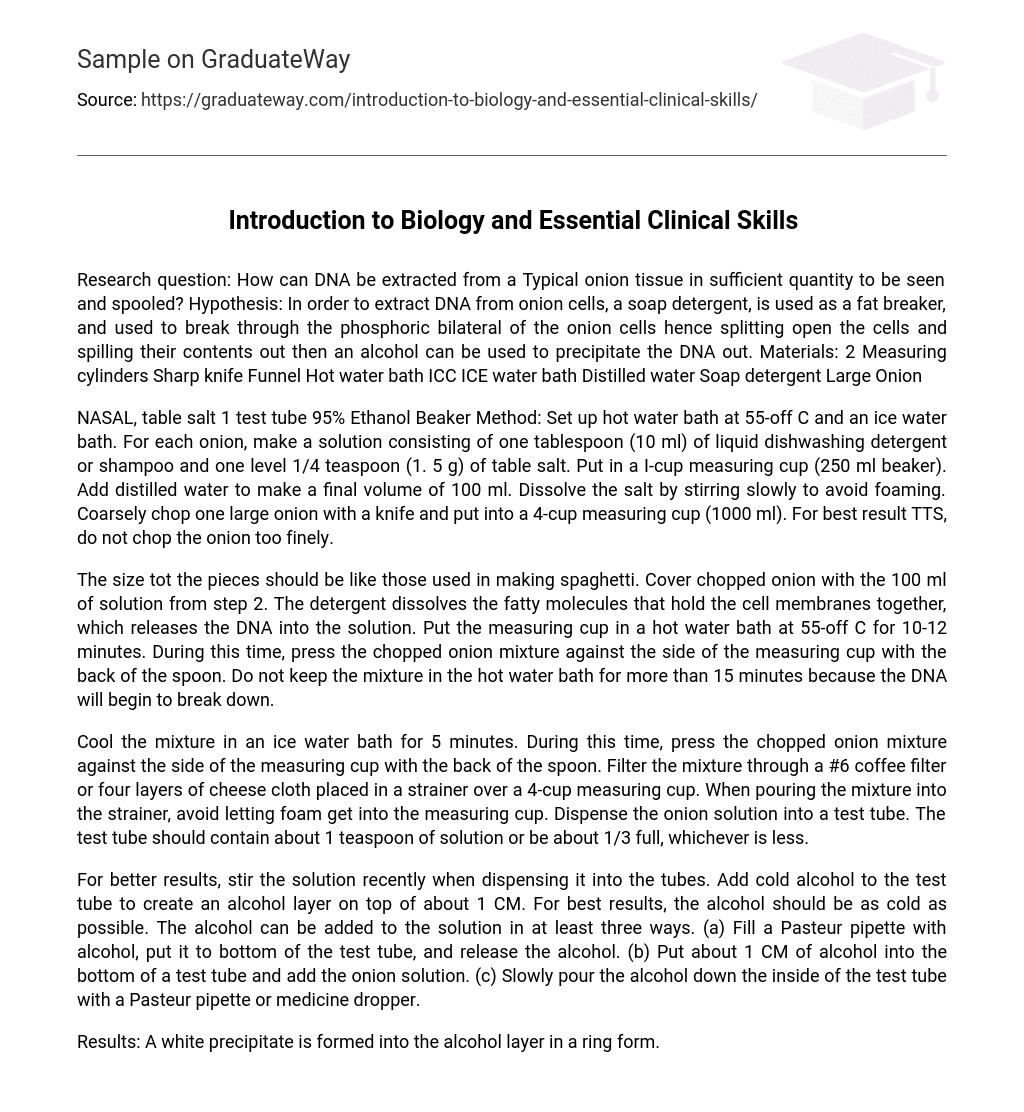Research question: How can DNA be extracted from a Typical onion tissue in sufficient quantity to be seen and spooled? Hypothesis: In order to extract DNA from onion cells, a soap detergent, is used as a fat breaker, and used to break through the phosphoric bilateral of the onion cells hence splitting open the cells and spilling their contents out then an alcohol can be used to precipitate the DNA out. Materials: 2 Measuring cylinders Sharp knife Funnel Hot water bath ICC ICE water bath Distilled water Soap detergent Large Onion
NASAL, table salt 1 test tube 95% Ethanol Beaker Method: Set up hot water bath at 55-off C and an ice water bath. For each onion, make a solution consisting of one tablespoon (10 ml) of liquid dishwashing detergent or shampoo and one level 1/4 teaspoon (1. 5 g) of table salt. Put in a I-cup measuring cup (250 ml beaker). Add distilled water to make a final volume of 100 ml. Dissolve the salt by stirring slowly to avoid foaming. Coarsely chop one large onion with a knife and put into a 4-cup measuring cup (1000 ml). For best result TTS, do not chop the onion too finely.
The size tot the pieces should be like those used in making spaghetti. Cover chopped onion with the 100 ml of solution from step 2. The detergent dissolves the fatty molecules that hold the cell membranes together, which releases the DNA into the solution. Put the measuring cup in a hot water bath at 55-off C for 10-12 minutes. During this time, press the chopped onion mixture against the side of the measuring cup with the back of the spoon. Do not keep the mixture in the hot water bath for more than 15 minutes because the DNA will begin to break down.
Cool the mixture in an ice water bath for 5 minutes. During this time, press the chopped onion mixture against the side of the measuring cup with the back of the spoon. Filter the mixture through a #6 coffee filter or four layers of cheese cloth placed in a strainer over a 4-cup measuring cup. When pouring the mixture into the strainer, avoid letting foam get into the measuring cup. Dispense the onion solution into a test tube. The test tube should contain about 1 teaspoon of solution or be about 1/3 full, whichever is less.
For better results, stir the solution recently when dispensing it into the tubes. Add cold alcohol to the test tube to create an alcohol layer on top of about 1 CM. For best results, the alcohol should be as cold as possible. The alcohol can be added to the solution in at least three ways. (a) Fill a Pasteur pipette with alcohol, put it to bottom of the test tube, and release the alcohol. (b) Put about 1 CM of alcohol into the bottom of a test tube and add the onion solution. (c) Slowly pour the alcohol down the inside of the test tube with a Pasteur pipette or medicine dropper.
Results: A white precipitate is formed into the alcohol layer in a ring form.
Conclusion and Evaluation: The white precipitate is the DNA, this supports the hypothesis because the liquid detergent broke the lipid bilateral of the onion cells pouring out its contents and since DNA is insoluble in alcohol every other component in the mixture except from DNA stayed in the solution while DNA (the white precipitate) is precipitated into the alcohol layer. And if the experiment was carried out accordingly there should be enough DNA to spool onto a glass rod or any similar device.





